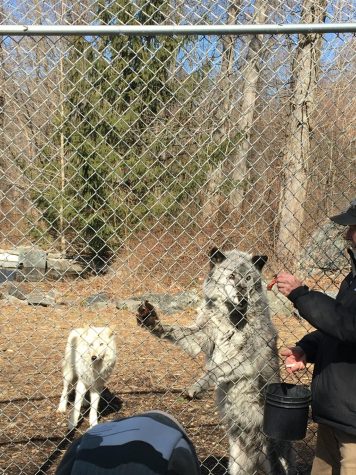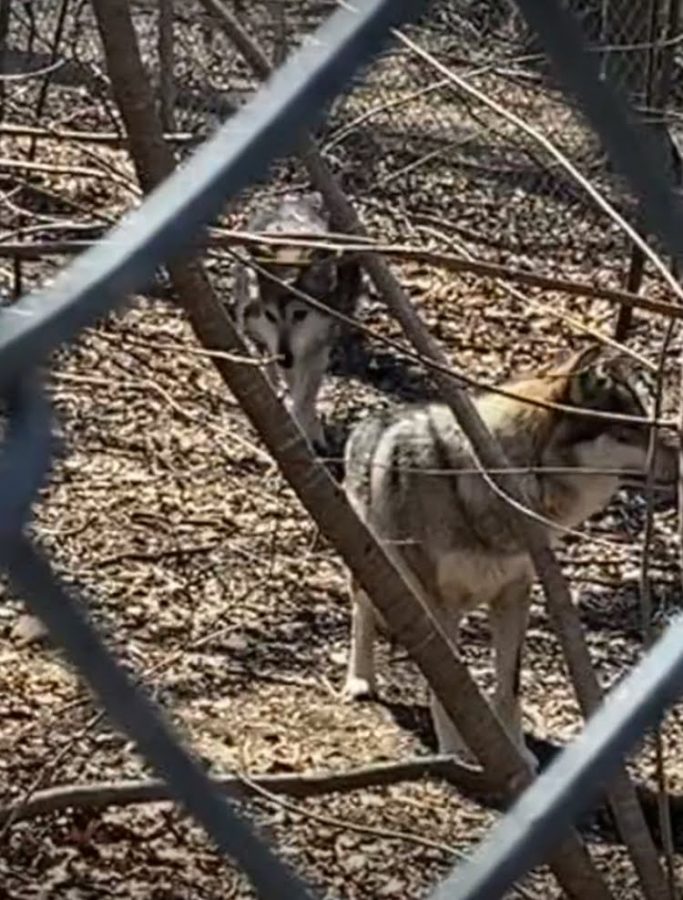Pace’s Nature Club visits Wolf Conservation Center
These are two of the Wolf Conservation Center’s resident Mexican gray wolves. The center raises and breeds wolves in an effort to preserve their species, and hopes to one day reintroduce these animals to their natural habitat.
On Saturday, March 7, the Nature Club took a trip to the Wolf Conservation Center (WCC) in South Salem. Nature Club president, junior Environmental Studies major Taylor Ganis, proposed the idea for the trip after she had the opportunity to volunteer there. Ganis thought it would be a unique experience for students that tied into the club’s goal of encouraging students to connect with the environment.
The center, which opened in 1999, educates people about the vital role that wolves play in the environment and helps grow the population of two endangered wolf species — the Mexican gray wolf and the red wolf — as part of the federal Species Survival Plan (SSP). This initiative, founded in 1981 and overseen by the American Zoo and Aquarium Association (AZA), seeks to build populations of endangered species that are healthy, genetically diverse, and sustainable through specialized captive breeding programs.
The WCC breeds and raises wolves with the hope of one day reintroducing them into their natural habitat. To ease this eventual transition, the organization keeps them in large enclosures with limited human contact and feeds them only roadkill deer, which WCC educator Joe Darling jokes is in large supply “thanks to all the lousy drivers around here.” To date, the WCC has been able to bring five wolves to live in their natural habitat, one red wolf and four Mexican gray wolves.
In addition to these wolves, the WCC is also home to three rocky mountain gray wolves- Zephyr, Nikai, and Alawa. These three “ambassador wolves” reside on exhibit as part of the WCC’s educational programs, which debunk common misconceptions about wolves and inform the public of wolves’ functions in the ecosystem so that people are more willing to support efforts to save their species. Despite popular belief and portrayal seen in fairytales and folklore, wolves do not seek to attack people. On the contrary. They generally fear and avoid people.
“This right here,” Darling said, gesturing to Zephyr as he ran up to the fence to greet the tour group and receive treats from Darling, “is very unusual behavior. Zephyr and our ambassador wolves will come up to the fence because they were raised around humans. But the others usually hide from visitors.”

Zephyr, an ambassador wolf at the WCC, comes up to the fence of his enclosure to receive a treat. Behind him is his sister Alawa.
When addressing the concerns that ranchers in the western part of the country have regarding wolves attacking their herds, Darling said that out of the millions of cows in Idaho, wolves only kill about 37 annually. He also said that this might actually benefit the ranchers. Since wolves go after weaker animals, they are likely to pick off sick animals among the herd before diseases have the chance to spread and wipe out a significant portion of it.
Click here for more information on the WCC.
Your donation supports independent, student-run journalism at Pace University. Support the Pace Chronicle to help cover publishing costs.


